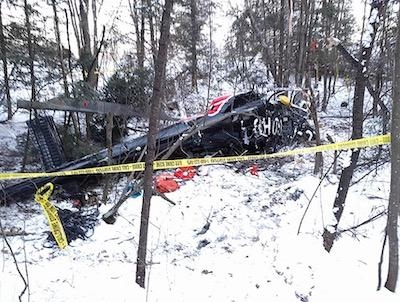Highlights Risks With External Cargo And Unrestrained Passengers, And Calls For Clarification Of Safety Belt Regulations
The Transportation Safety Board of Canada (TSB) has released its investigation report (A17O0264) on a fatal helicopter accident near Tweed, Ontario, which occurred in December 2017. In doing so, the Board called on Transport Canada to clarify the definition of safety belt in the Canadian Aviation Regulations to reduce the risks of injury or death during a survivable accident.

On 14 December 2017, an Airbus AS 350 B2 helicopter owned by Hydro One Networks Inc. was transporting three power line technicians from a transmission tower to a staging area near Tweed, Ontario. During the descent, an empty canvas supply bag blew off from an external platform attached to the aircraft and, along with its carabiner, struck and severely damaged the tail rotor. Shortly after, the helicopter became uncontrollable and collided with terrain. All occupants were fatally injured.
Within a few days of the accident, the TSB issued a safety advisory to raise awareness about the risks associated with unsecured cargo and unrestrained passengers in aircraft. During its investigation, the TSB found that the practice of carrying external loads attached to the platform, for flight to and from work sites, was not a formalized procedure at the company and, as a result, adequate controls were not in place to ensure that objects were properly stored or secured.
The investigation also found that prior to the occurrence, the shoulder harness portions of the backseat safety belts were rolled up and taped with electrical tape, thereby preventing their use. There was a perception within the company that the use of the shoulder harness was optional as long as the lap strap was used. "The Canadian Aviation Regulations currently define a safety belt as "a personal restraint system consisting of either a lap strap or a lap strap combined with a shoulder harness," said Kathy Fox, Chair of the TSB. "Because of the word either, pilots and passengers may interpret the regulation to mean that use of the lap strap alone is sufficient. We want that uncertainty removed."
After the accident, Transport Canada published a safety letter that emphasized the importance of pilots wearing both the lap strap and the shoulder harness portion of the safety belt, whenever it is available. Hydro One Networks Inc. also took a number of corrective actions, such as suspending operations involving the external platform, completing a comprehensive review of its operations manual and procedures, and enhancing its training programs.
See the investigation page for further information and more details about the Board's recommendation and the investigation findings.
The TSB is an independent agency that investigates air, marine, pipeline, and rail transportation occurrences. Its sole aim is the advancement of transportation safety. It is not the function of the Board to assign fault or determine civil or criminal liability.
(Source: Transportation Safety Board of Canada. Image provided)
 Classic Aero-TV: Remembering Bob Hoover
Classic Aero-TV: Remembering Bob Hoover ANN FAQ: Follow Us On Instagram!
ANN FAQ: Follow Us On Instagram! ANN's Daily Aero-Linx (05.15.24)
ANN's Daily Aero-Linx (05.15.24) ANN's Daily Aero-Term (05.15.24):Altimeter Setting
ANN's Daily Aero-Term (05.15.24):Altimeter Setting Aero-News: Quote of the Day (05.16.24)
Aero-News: Quote of the Day (05.16.24)



